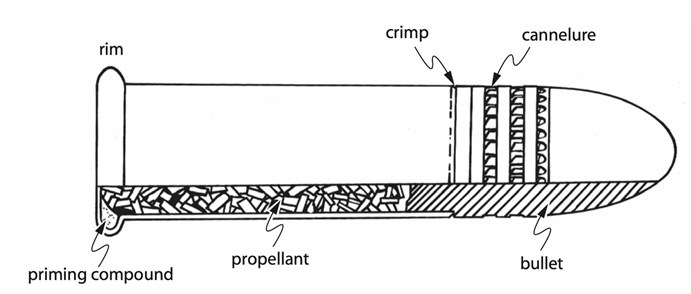Rimfire Roster: Smallest Calibers, By the Numbers
What’s the difference between all those kinds of .22 ammo? Some critical facts … and some history you didn’t know!
When most people think of rimfire ammunition, they think of the most common cartridge in the world—the .22 LR. There are two types of cartridges: rimfire and center-fire. The location of the primer and primer compounds is what separates the two types. Rimfire cartridges have their primer compound located in the rim of the cartridges. Center-fire cartridges have their primer inserted in the primer pocket of the case, located in the center of the case head.


Rimfire cartridges are sometimes thought of as small and less powerful rounds as compared to centerfire cartridges. Rimfire ammunition bullets range from 15.5 to 50 grains. The velocities of rimfire cartridges range from 1,164 feet per second (fps) to almost 2,400 fps. Pressures of these cartridges range from 21,000 PSI (pounds per square inch) to an astonishing 52,000 PSI. As you can see, rimfire cartridges can hold their own in the ammunition world!
Many times, rimfire cartridges do not get the respect they deserve. I have often heard people say, “It’s just a .22.†All calibers need to be respected and handled safely. Rimfire ammunition can be just as deadly as larger calibers, if handled carelessly. The more common rimfire cartridges that are in production today are: the .22 Short, .22 Long, .22 LR, .22 WMR and .17 HMR.
.22 Short
The .22 Short was developed in 1857 by Smith & Wesson for its first revolver. It is still produced today, making it the oldest cartridge in use to date. The bullet weight of the .22 Short is between 27 grains and 29 grains. Muzzle velocities range from 1,080 (f.p.s.) to over 1,105 f.p.s. The .22 Short can travel up to 1 mile under ideal conditions.

The .22 Short was originally developed for a pocket gun for self-defense. It was soon used in carnivals and fairs in their midways for target shooting. It is still used for killing small birds and animals, but has been overtaken by the .22 LR.
.22 Long
The .22 Long was developed in 1871 by the Stevens Arms Company. The bullet weight of the .22 Long can be between 30 grains to 40 grains. Muzzle velocities range from 1,100 f.p.s to over 1,215 f.p.s. The .22 Long can travel up to 1½ miles under ideal conditions.


The .22 Long was developed as a small-game cartridge. Originally chambered in revolvers, it was soon chambered in rifles because it was so effective on rabbits, squirrels, etc. Like the .22 Short, the .22 Long was also replaced by the .22 LR.
.22 LR (Long Rifle)
The .22 LR was developed in 1884 by the Union Metallic Cartridge Company. The .22 Long is the second-oldest cartridge still being used today. The bullet weight of the .22 LR can be as light as 20 grains to its top weight of 60 grains. Muzzle velocities range from 1,100 f.p.s. to over 1,400 fps. The .22 LR can travel up to 1½ miles under ideal conditions.

The .22 LR is the most versatile of the rimfire cartridges. This cartridge has been chambered in revolvers, rifles, semi-automatic pistols, semi-automatic rifles and full-auto rifles. The .22 LR is used in many competitive shoots; hundreds of thousands of Boy Scouts have shot this popular round at summer camps across the nation. There is even a Rifle Merit Badge to be earned once a Scout has shown proficiency on the range. The NRA also suggests using .22 LRs for teaching the NRA Basic Rifle and NRA Basic Pistol courses.
.22 WMR (Winchester Magnum Rimfire)
The .22 WMR was developed in 1959 by Winchester. The bullet weight of the .22 WMR is between 30 grains and 50 grains. Muzzle velocities range from 1,875 fps to over 2,250 fps. The .22 WMR can travel up to 2 miles under ideal conditions.
Even though Winchester developed the .22 WMR in 1959, the company did not have a rifle chambered for it in 1960—the Winchester Model 61 pump action rifle came out in ‘61. Beating Winchester to the punch, Marlin introduced a lever- action rifle and Smith & Wesson and Ruger produced revolvers chambered for .22 WMR.

.17 HMR (Hornady Magnum Rimfire)
The first commercial .17 HMR was introduced in 2002 by Hornady. This cartridge rose out of “wildcatters†(individuals developing new cartridges) who were trying to match the ballistics of the obsolete 5 mm Remington Magnum Rimfire. It was developed by necking down a .22 WMR to accept a .17 caliber bullet.
The bullet weight of the .17 HMR ranges from 15.5 grains to 20 grains. Muzzle velocities range from 2,375 fps to over 2,525 fps. The .17 HMR can travel up to 1½ miles under ideal conditions.

The .17 HMR has a very dedicated following. You can find this cartridge at the range as well as in the field. Many varmint hunters rely on the .17 HMR to take everything from fox and bobcat to even coyotes. The fast bullet, with proper placement, is more than adequate in taking furbearing animals while at the same time doing minimum damage to the pelts.
